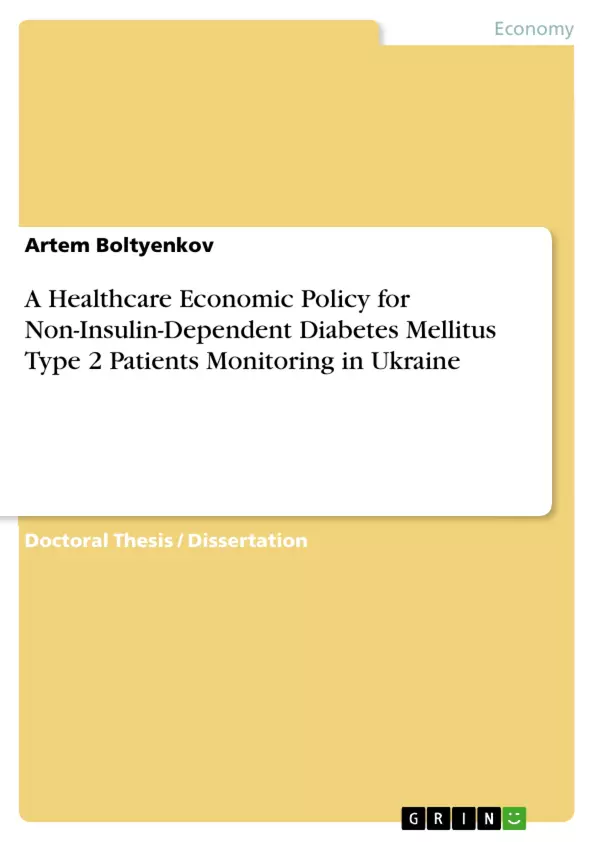This research explores the cost, life expectancy and quality of life impact of a national quarterly monitoring program on type 2 diabetes for non-insulin-dependent patients. In Ukraine, many people suffer from diabetes and its complications. In this research we focus only on type 2 diabetes, as the most common type of diabetes. Among those we focus only on non-insulin-dependent patients, as these are the patients that would benefit the most from the improved monitoring. Diabetes leads to lower life expectancy, lower quality of life of an individual, and higher healthcare costs both for people and the healthcare system. This burden increases even more if diabetes is not managed. The research analyses the potential impact of a nationwide point of care based non-insulin-dependent diabetics monitoring program.
The research method used in the study is the combined cost-effectiveness analysis and budget impact analysis from the payer perspective. This is a special type of the summative evaluation research used to assess the impact of a healthcare program. With the research method, the author answers the question whether the proposed diabetes monitoring strategy is more cost-effective than the standard of care. The author also answers the question what the impact of a nation-wide diabetes monitoring program on the annual healthcare budget of the payer would be. He also analyses the average cost associated with diabetes during the lifetime of an average patient from the payer perspective; the impact on the quality of life of such a patient, and on her (his) life expectancy. All this provides important information to assess the impact of an alternative healthcare economic policy for diabetes. Two formal decision scientific models were developed. They model the situation of diabetics with quarterly point of care based HbA1c monitoring program and compare it with the standard of care. The main types of input data for the models are transition probabilities between different health states, cost and utility of each individual health state. The data used in the models were taken from the literature review of publications and discussions with healthcare professionals in Ukraine.
Inhaltsverzeichnis (Table of Contents)
- Abstract
- Dedication
- Statement of Originality
- Abstract
- Introduction
- Diabetes in Ukraine
- Type 2 Diabetes
- Non-Insulin-Dependent Patients
- Burden of Diabetes
- Need for Improved Monitoring
- Research Methodology
- Cost-Effectiveness Analysis
- Budget Impact Analysis
- Summative Evaluation Research
- Payer Perspective
- Model Development
- Formal Decision Scientific Models
- Transition Probabilities
- Cost and Utility of Health States
- Data Sources
- Results
- Cost-Effectiveness of HbA1c Monitoring
- Impact on Life Expectancy and Quality of Life
- Budget Impact
- Cost-Effectiveness Threshold
- Discussion
- Implications for Healthcare Policy
- Future Research Directions
- Conclusion
Zielsetzung und Themenschwerpunkte (Objectives and Key Themes)
This research aims to assess the cost-effectiveness and budget impact of a national quarterly monitoring program for non-insulin-dependent type 2 diabetes patients in Ukraine. The study utilizes a combined cost-effectiveness and budget impact analysis from the payer perspective to evaluate the program's impact on healthcare costs, life expectancy, and quality of life for patients.
- Cost-effectiveness of diabetes monitoring programs
- Budget impact of a national diabetes monitoring program
- Impact of diabetes on life expectancy and quality of life
- Healthcare economic policy for diabetes management in Ukraine
- Application of decision scientific models in healthcare policy evaluation
Zusammenfassung der Kapitel (Chapter Summaries)
The research begins by outlining the significant burden of diabetes in Ukraine, focusing on the prevalence of type 2 diabetes and the need for improved monitoring strategies for non-insulin-dependent patients. The study then details the methodology used, including cost-effectiveness analysis, budget impact analysis, and the payer perspective. This is followed by a description of the decision scientific models developed to simulate the impact of the proposed monitoring program. The results section presents key findings on the cost-effectiveness of the HbA1c monitoring program, its impact on life expectancy and quality of life, and the budget implications. The discussion section explores the implications of the findings for healthcare policy and outlines future research directions.
Schlüsselwörter (Keywords)
The primary keywords and focus topics of this research are: diabetes, healthcare economic policy, cost-effectiveness, budget impact, non-insulin-dependent diabetes mellitus type 2, HbA1c monitoring, quality of life, life expectancy, and decision scientific models.
- Quote paper
- Artem Boltyenkov (Author), 2021, A Healthcare Economic Policy for Non-Insulin-Dependent Diabetes Mellitus Type 2 Patients Monitoring in Ukraine, Munich, GRIN Verlag, https://www.grin.com/document/1239366



